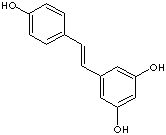PRODUCT IDENTIFICATION
61434-67-1 (cis-)

H.S. CODE
TOXICITY
C(=C\c1ccc(cc1)O)\c1cc(O)cc(c1)O
CLASSIFICATION
Non-Narcotic analgesic, Anti-Inflammatory, Anticarcinogenic, Antimutagenic, Antineoplastic, Antioxidant, Antirheumatic, Hematologic, Peripheral Nervous System Agent, Platelet aggregation inhibitor
EXTRA NOTES
NCI: A phytoalexin derived from grapes and other food products with antioxidant and potential chemopreventive activities. Resveratrol induces phase II drug-metabolizing enzymes (anti-initiation activity); mediates anti-inflammatory effects and inhibits cyclooxygenase and hydroperoxidase functions (anti-promotion activity); and induces promyelocytic leukemia cell differentiation (anti-progression activity), thereby exhibiting activities in three major steps of carcinogenesis. This agent may inhibit TNF-induced activation of NF-kappaB in a dose- and time-dependent manner. ... (NCI Thesaurus)
PHYSICAL AND CHEMICAL PROPERTIES
pale yellow powder
252 - 254 C
AUTOIGNITION
NFPA RATINGS
REFRACTIVE INDEX
EXTERNAL LINKS & GENERAL DESCRIPTION
Wikipedia Linking - Resveratrol
Google Scholar Search - Resveratrol
Drug Information Portal (U.S. National Library of Medicine) - Resveratrol
PubChem Compound Summary - Resveratrol
Drug Bank - Resveratrol
KEGG (Kyoto Encyclopedia of Genes and Genomes) - Resveratrol
http://www.ebi.ac.uk/ - Resveratrol
http://www.ncbi.nlm.nih.gov/ - Resveratrol
http://toxnet.nlm.nih.gov/
Hazardous
Substances Data Bank - Resveratrol
http://www.sigmaaldrich.com/
Biochem/physiol Actions:Resveratrol is a phenolic phytoalexin found in grape skin and other plants. It has intracellular antioxidant activity and activates SIRT1, a NAD+-dependent histone deacetylase involved in mitochondrial biogenesis and the enhancement of peroxisome proliferator-γ-activated receptor coactivator-1α (PGC-1α) and FOXO activity. The anti-diabetic, neuroprotective and anti-adipogenic actions of resveratrol may be mediated via SIRT1 activation.
Local
Resveratrol (3,5,4'-trihydroxystilbene) is a
non-flavonoid polyphenolics compound found highly in the skin of red grapes and
as a constituent of red wine. It is also found in teas, berries and peanuts.
Resveratrol is a compound of stilbene structure (and is responsible for the
principle coloring of the plants. Resveratrol is created by plants as a phytoalexin (plant's defense
arsenal) against bacteria
and fungi. It is marketed as a nutritional supplement that shows health-giving antioxidant effects such
as anti-cancer, antiviral, and anti-aging. Resveratrol inhibits COX-1 enzyme and
demonstrates anti-inflammatory effects. It is a platelet aggregation inhibitor
to block the adhesion of blood cells to vessel walls and therefore prevents
heart disease and cerebral apoplexy.
It exists as two structural isomers: cis- (Z)
and trans- (E),
Piceatannol or 3,4,3',5'-tetrahydroxy-trans-stilbene is a phenolic that is structurally related to resveratrol. Piceatannol has one more hydroxyl group at 3' position. It is a metabolite of resveratrol and is found in red wine. Pterostilbene (3,5-Dimethoxy-4'-hydroxy-trans-stilbene) is an analog of resveratrol. The two phenolic hydroxyl groups among three are converted to methyl ethers. Some reports say that the ethers enhance antioxidant effects.
APPEARANCE
pale yellow powder
98.0% min
HEAVY METALS
10ppm max
PESTICIDE RESIDUE
Non
ASH
1.0% max
LOSS ON DRYING
5.0% max
AEROBIC PLATE
Total plate count: 1000CFU/G
max
E. coli: Negative
Salmonella:
Negative
Total Mold/Yeast: 100 cfu/g max
HAZARD OVERVIEW
Harmful if swallowed. Risk of serious damage to eyes. Irritating to respiratory system and skin. May cause an allergic skin reaction.
GHS
PICTOGRAMS

HAZARD STATEMENTS
H319
P STATEMENTS
P305 + P351 + P338
![]()
RISK PHRASES
36
SAFETY PHRASES
26